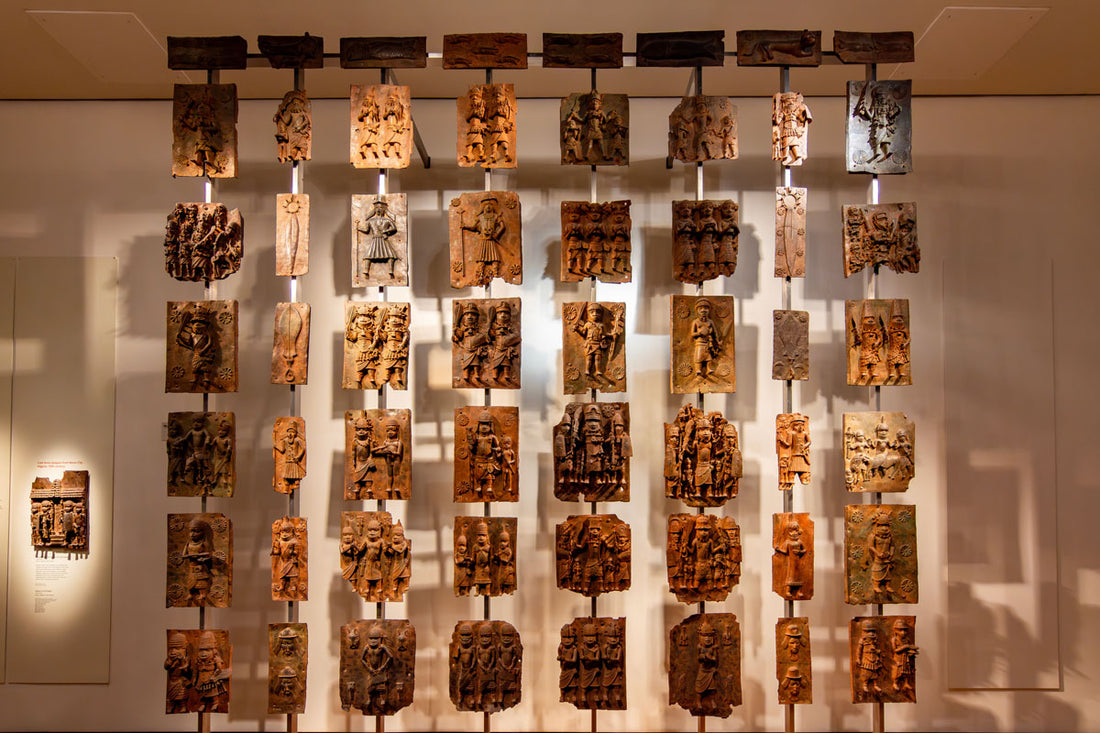
Is investing in African Art a Stable Haven in Uncertain Markets?
Share
In today’s volatile economic climate, investors are increasingly seeking alternative assets that offer both stability and strong appreciation potential. With global markets rattled by sweeping tariffs, geopolitical tensions, and a looming recession, one asset class has demonstrated remarkable resilience: African art.
In the last decade, African art—particularly works from established traditions like Benin Bronzes and Senufo sculptures, as well as contemporary African artists—has not only held its value but surged in auction prices. We’ll examine why African art is a compelling investment, how U.S. tariffs are disrupting traditional markets, and why collectors and investors should consider this growing asset class.
The Destabilizing Impact of U.S. Tariffs on Traditional Investments
The U.S. has imposed unprecedented tariffs on countries worldwide, particularly China and Europe, creating uncertainty in global trade. These policies have led to:
- Supply chain disruptions, increasing costs for manufacturers and retailers
- Stock market volatility, as trade wars weigh on corporate earnings
- Currency fluctuations, particularly in emerging markets
- Recession Risk, as global trade cools
While equities and real estate remain popular investments, their susceptibility to macroeconomic shocks makes diversification crucial. African art, however, operates outside these pressures. Unlike tech stocks or consumer goods, it isn’t subject to tariffs, trade disputes, or supply chain bottlenecks. Instead, its value is driven by cultural significance, rarity, and increasing global demand—factors that make it an attractive hedge against economic instability.

African Art as a Store of Value: Auction Records Speak for Themselves
The auction market for African art has seen explosive growth, with Sotheby’s, Christie’s, and Bonhams reporting record-breaking sales. Consider these recent highlights:
- A Benin Bronze head sold for $10.4 million at Sotheby’s in 2021, shattering previous records.
- A Fang Reliquary Figure fetched $7.5 million in 2022, demonstrating the high demand for classical African pieces.
- Contemporary African artists like El Anatsui and Julie Mehretu now command seven-figure prices, proving the market’s expansion beyond antiquities.
These numbers reflect a broader trend: African art is no longer a niche market but a major player in global auctions.
Why African Art Holds Its Value
- Scarcity & Provenance – Many classical African artworks were looted during colonial periods, making legally acquired pieces extremely rare. As museums and collectors face pressure to repatriate artifacts, ethically sourced works are becoming even more valuable.
- Cultural Significance – Unlike stocks or bonds, African art carries deep historical and spiritual meaning, making it inherently valuable beyond financial metrics.
- Growing Institutional Demand – Major museums (like the Metropolitan Museum of Art and the British Museum) are expanding their African art collections, driving up prices.
- Diversification Benefits – Art has a low correlation with traditional markets, meaning it can retain value even during economic downturns.
How to Invest in African Art: A Strategic Approach
For investors new to this space, here’s a structured way to enter the market:
Focus on Established Categories
- Classical African Art (Benin Bronzes, Dogon figures, Senufo furniture) – High-value, but requires expertise in authenticity.
- Modern African Masters (Ben Enwonwu, Irma Stern) – Recognized names with strong resale markets.
- Contemporary African Artists (El Anatsui, Njideka Akunyili Crosby) – Fast-growing segment with global appeal.
Verify Provenance & Authenticity
- Work with reputable auction houses (Sotheby’s, Christie’s, Bonhams).
- Consult specialist dealers in African art to avoid fakes.
- Check for certificates of authenticity and legal documentation.
Consider Long-Term Holding Periods
Like fine wine or rare watches, African art appreciates best over 5–10 years. Short-term flipping is risky due to market liquidity constraints.
Diversify Within the Asset Class
Instead of putting all capital into one high-value piece, consider a mix:
- One classical piece (e.g., a Mende mask)
- One modern work (e.g., a Skunder Boghossian painting)
- One contemporary investment (e.g., a photograph by Omar Victor Diop)
Risks & Challenges
While African art offers strong returns, it’s not without risks:
- Fakes & Forgeries – The market has seen an increase in counterfeit pieces.
- Liquidity Constraints – Selling a high-value artwork quickly can be difficult.
- Repatriation Pressures – Some countries are reclaiming looted art, which could affect ownership rights.
Mitigation Strategy: Stick to well-documented pieces and insure high value acquisitions.
Conclusion: Why African Art Belongs in Your Portfolio
In an era of trade wars, inflation, and market instability, African art stands out as a tangible, culturally rich, and appreciating asset. Unlike stocks tied to geopolitical risks or real estate vulnerable to economic cycles, African art has shown consistent growth, driven by scarcity, institutional demand, and global recognition.
For investors looking to diversify beyond traditional markets, African art offers a unique opportunity—one that combines financial upside with cultural legacy. As auction records continue to climb, now may be the ideal time to explore this dynamic market.
This is not financial advice. Any investment has inherent risks. Consult a licensed advisor before making any financial investment decisions.

